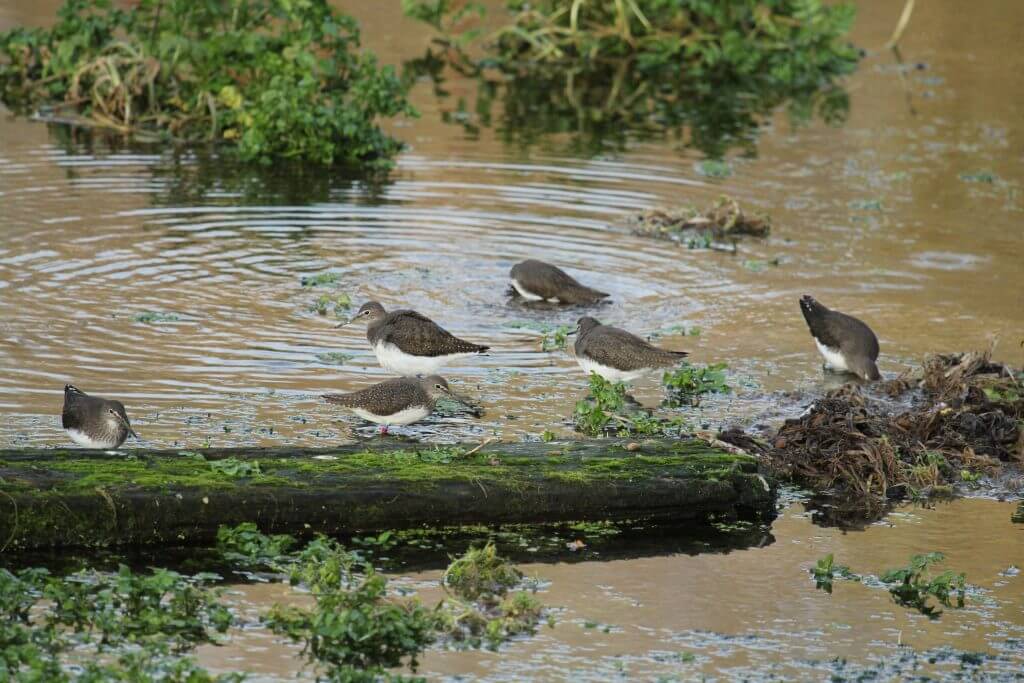![By J.M.Garg (Own work) [GFDL (http://www.gnu.org/copyleft/fdl.html) or CC BY-SA 4.0-3.0-2.5-2.0-1.0 (http://creativecommons.org/licenses/by-sa/4.0-3.0-2.5-2.0-1.0)], via Wikimedia Commons](https://markavery.info/wp-content/uploads/2016/09/Green_Sandpiper_Tringa_ochropus_W_IMG_6454.jpg)
Modern technology is opening up the details of bird movements in a very exciting way.
A Green Sandpiper was fitted with a GPS tag at Lemsford Springs, near Welwyn Garden City in Hertfordshire in April this year and was recaptured there, enabling the tag to be removed, on 30 July. GPS tags collect information on their wearers’ positions on Earth but do not transmit that information (as do radio tags or satellite tags): you need to catch the bird, remove the tag and download the data. But as we’ve seen with other species (eg Red-necked Phalarope, Nightingale, Swift) even the data from a few birds can tell us things that we never knew about species, just as a close encounter with an alien life form would unlock a whole new world for us.
This Green Sandpiper headed to Norway in an apparent non-stop flight of 900 miles across the North Sea starting on 26 April and arriving on 28 April. Aren’t birds just amazing?

Laura Baker, Lemsford Springs Reserves Officer, said: ‘Lemsford Springs Nature Reserve is a very special site in the UK for wintering green sandpipers. Last year we distributed 85 tonnes of gravel here, to improve the specialised habitat of the cress beds. This supports a large number of freshwater shrimps, welcome food for our green sandpipers and lots of other wildlife. We will be continuing this work and look forward to welcoming more people to the reserve so we can show them how special this place is for wildlife.‘.
Barry Trevis, Volunteer Warden at Lemsford Springs Nature Reserve, said: ‘From the end of April to mid-June the bird moved to North Norway, near Trondheim, to breed. After being tracked to a small lake between Hatfield and St Albans on 21st June, it was next seen at Lemsford on 15th July. I was able to recapture the bird on 30th July, when the tag was removed and the sandpiper released. We have seen the sandpiper regularly on the lagoons since then.‘.
OK, here is the second-most interesting fact you will learn about Green Sandpipers today: where do you think they nest?
This wader doesn’t nest on the ground, as you might have imagined, and as do the rather similar Common Sandpiper and Wood Sandpiper, but in the former nests of birds such as Mistle Thrushes and Fieldfares, often up in the trees. How about that? Aren’t birds amazing?
Green Sandpipers have been studied at Lemsford Springs by Barry Trevis, Ken Smith and Mike Reed, since 1983. I remember Ken asking me to look out for colour-ringed Green Sandpipers on a trip to East Africa! The birds are known to spend up to 10 months a year on the reserve and nearby wetlands, many returning year after year. Green Sandpipers usually migrate to Northern and Eastern Europe to breed, with just a few pairs recorded breeding in northern Scotland.
[registration_form]
I love this story. I have never knowingly seen a Green Sandpiper – even Common ones, aren’t, to me. After woodland, I think wetlands are my next favourite habitat but I don’t know where the closest/best ones are to me in my new Devon home, though I have enjoyed my visits to Bowling Green Marsh on the River Exe. There are so many different bird species that enjoy wetland habitat and I feel my knowledge is at its weakest in that area. So much wildlife (still a few scraps left), so little time…
I’m amazed to read this bird nests in trees, and in former nests of thrushes and fieldfares… it’s seems too big a bird for that. And I love the idea of looking for Hertfordshire birds in East Africa. I was surprised enough, this last time year, seeing an Osprey (which I associate with Scotland, or Rutland Water) fly past me on my local South Devon beach! I know they migrate, and I know it’s ‘normal’, but for me, very little feels ‘normal’ when it comes to bird behaviour: in particular, migration, and the distances these little creatures cover. Travel safe as you go this year, birds.
Daphne – you are at the stage of wonder and marvelling that many of us went through as kids, and maybe didn’t make the most of at that time. All those ‘I didn’t know that. How amazing!’ moments. Do enjoy them!
I find I have them with butterflies and invertebrates all the time – it’s one of the benefits of expanding one’s horizons a bit – new excitement!